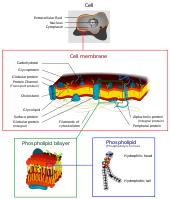
Photo from wikipedia
Abstract The structure of amino acids in peptides significantly affect the supramolecular architecture. Even small changes in the peptide molecular structure can have dramatic impact on the morphology of the… Click to show full abstract
Abstract The structure of amino acids in peptides significantly affect the supramolecular architecture. Even small changes in the peptide molecular structure can have dramatic impact on the morphology of the assemblies. Herein, we demonstrate that the replacement of the four hydrophobic amino acid residues I in Ac-KI4K-NH2 (KI4K) for nleucine (Nle), leucine (L), and tert-leucine (Tle) can greatly affect the aggregate morphology and their self-assembling abilities. As for KI4K, the β-branch carbon in the hydrophobic amino acid I greatly promotes the lateral association of β-sheets and facilitate the formation of wider nanotubes. When the four hydrophobic residues I was replaced by Nle or L, thin nanotubes with quite small inner diameter were dominant for Ac-K(Nle)4K-NH2 (K(Nle)4K) while only thin nanofibers can be obtained for Ac-KL4K-NH2 (KL4K), suggesting the important roles of the four β-branch carbon in promoting the lateral association of β-sheets. On the contrary, no obvious aggregate structure was observed for Ac-K(Tle)4K-NH2 (K(Tle)4K) due to the strong steric hindrance interactions. Small angle neutron scattering (SANS) results indicated the different inner structure information for the nanotubes and nanofibers even though they share the same basic lamellar structure. Circular dichroism (CD), Fourier transform infrared spectroscopy (FTIR), and thioflavin-T (ThT) experiments indicated their different secondary structure and self-assembling abilities. These results can help us further understand the roles of β-branch carbon in controlling the aggregate morphology, which can benefit further research in establishing the relationship between the molecular structure and the final aggregate morphology.
Journal Title: Journal of Molecular Liquids
Year Published: 2020
Link to full text (if available)
Share on Social Media: Sign Up to like & get
recommendations!